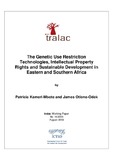The Genetic Use Restriction Technologies, Intellectual Property Rights and Sustainable Development in Eastern and Southern Africa

View/
Date
2006Author
Kameri-Mbote, Patricia
Otieno-Odek, James
Type
Working PaperLanguage
enMetadata
Show full item recordAbstract
Many eastern and southern African countries have had to revisit their intellectual
property rights regimes in response to the Agreement on Trade-Related Aspects of
Intellectual Property Rights (TRIPs) of the World Trade Organization (WTO). This has
coincided with the development of new technologies that necessitate changes in the
domestic laws on the protection of new inventions. The dearth of human and resource
capacity in both intellectual property and the emerging technologies has constrained the
space that these countries have to think through and respond to the needs considering
their national development agendas. The countries have therefore engaged in legislative
changes at the domestic level purely as a legal requirement without the benefit of
analyses on the impacts of the changes on the countries and the region as a whole. The
protection of genetic use restriction technologies (GURTs) through intellectual property
rights could, for instance, impact significantly on access to technology by farmers in the
region. However, this has not been explicitly addressed in the Intellectual Property (IP)
legislation. The ambivalence of this legislation to GURTS can, in some instances, be
interpreted as support for GURTS IPRs.
It is in the light of this that the Trade Law Centre for Southern Africa (tralac) and the
International Centre for Trade and Sustainable Development (ICTSD) commissioned
this research on the interface between GURTs and intellectual property rights (IPRs) on
sustainable use of agro-biodiversity and food security. There is particular concern that
IPRs would have a negative impact on agriculture, which is the biggest employer and a
great contributor to the economies of Eastern and Southern African (ESA) countries.
This study examines the role of IPRs in the region and the place of GURTs in that
schema. It looks particularly at the role of IPRs in development and the arguments for
and against GURTs, proposing possible responses that ESA countries could consider to
mitigate the potential adverse impacts of IPRs for GURTs on agriculture in the region.
This paper is divided into seven parts. Part I comprises the executive summary. Part II
(1) introduces both IPRs and GURTs from a global perspective but contextualises them
Publisher
Department of Public Law
Collections
- School of Law [80]
